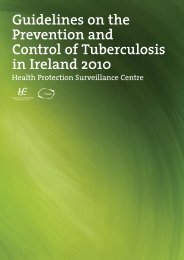Guidelines for the Early Clinical and Public Health Management of ...
Guidelines for the Early Clinical and Public Health Management of ...
Guidelines for the Early Clinical and Public Health Management of ...
Create successful ePaper yourself
Turn your PDF publications into a flip-book with our unique Google optimized e-Paper software.
<strong>Guidelines</strong> <strong>for</strong> <strong>the</strong> <strong>Early</strong> <strong>Clinical</strong> <strong>and</strong> <strong>Public</strong> <strong>Health</strong> <strong>Management</strong> <strong>of</strong> Bacterial Meningitis (including Meningococcal Disease)<br />
Invasive pneumococcal disease – meningitis or septicaemia<br />
What is pneumococcal disease<br />
Pneumococcal disease is caused by a bacterium called Streptococcus pneumoniae. This bacterium is <strong>the</strong> most<br />
common bacterial cause <strong>of</strong> community-acquired pneumonia <strong>and</strong> a common cause <strong>of</strong> bacteraemia <strong>and</strong> meningitis in<br />
children <strong>and</strong> adults. There are over 90 types <strong>of</strong> S. pneumoniae known (<strong>the</strong>se are called serotypes).<br />
What diseases does pneumococcus cause<br />
The most common types <strong>of</strong> infections caused by S. pneumoniae include:<br />
• Middle ear infections (acute otitis media), particularly common in children<br />
• Pneumonia<br />
• Bacteraemia (blood stream infection)<br />
• Sinus infections <strong>and</strong><br />
• Meningitis<br />
How common is pneumococcal disease<br />
Pneumococcal infection is a leading cause <strong>of</strong> death worldwide. Mortality is highest in patients who develop<br />
bacteraemia or meningitis. Pneumococcal pneumonia is estimated to affect 0.1% <strong>of</strong> <strong>the</strong> population every year.<br />
Who is most at risk <strong>of</strong> pneumococcal disease<br />
Individuals most at risk <strong>of</strong> pneumococcal infections are<br />
• <strong>the</strong> very young or <strong>the</strong> very old<br />
• people with a chronic illness such as diseases <strong>of</strong> heart, lung, kidneys or liver<br />
• people without a spleen or with a damaged spleen<br />
• people whose immune system is not working properly.<br />
How do people get infected<br />
People can get infected by person-to-person spread, usually through respiratory droplet spread, but may be by direct<br />
oral contact or indirectly through articles contaminated with respiratory discharges. The bacteria is spread through<br />
contact between persons who are ill or who carry <strong>the</strong> bacteria in <strong>the</strong>ir throat (<strong>of</strong>ten without being ill). It is extremely<br />
rare <strong>for</strong> healthy people to catch <strong>the</strong> infection from a relative or a member <strong>of</strong> <strong>the</strong>ir household.<br />
How is pneumococcal disease treated<br />
Pneumococcal disease is treated with antibiotics. In recent years many pneumococci have become resistant to some<br />
<strong>of</strong> <strong>the</strong> antibiotics used to treat pneumococcal infections; high levels <strong>of</strong> resistance to penicillin are uncommon.<br />
How is pneumococcal disease prevented<br />
The most common types <strong>of</strong> pneumococcal disease can be prevented by vaccination. Vaccination is recommended <strong>for</strong><br />
those most at risk <strong>of</strong> disease. Since 2008 all children are recommended <strong>the</strong> pneumococcal vaccine.<br />
Pneumococcal vaccines<br />
There are two different types <strong>of</strong> pneumococcal vaccine:<br />
1. Pneumococcal Polysaccharide Vaccine (PPV23). This incorporates 23 <strong>of</strong> <strong>the</strong> most common strains <strong>of</strong><br />
pneumococcus. It is only suitable <strong>for</strong> use in those ≥2 years <strong>of</strong> age.<br />
2. Pneumococcal Conjugate Vaccines are used in <strong>the</strong> childhood immunisation schedule at 2, 6, <strong>and</strong> 12 months. The<br />
vaccine currently used protects against 13 strains. These vaccines are used in children because <strong>the</strong>y are more suitable<br />
<strong>for</strong> children than <strong>the</strong> polysaccharide vaccines.<br />
Are close contacts ever <strong>of</strong>fered antibiotics<br />
If two or more cases <strong>of</strong> serious pneumococcal disease are identified in a closed setting (household, school or o<strong>the</strong>r<br />
closed environment) <strong>the</strong>re may be a slightly increased risk <strong>of</strong> developing <strong>the</strong> infection among <strong>the</strong> close contacts.<br />
In <strong>the</strong>se circumstances close contacts may be <strong>of</strong>fered antibiotics <strong>and</strong> sometimes immunisation as a precautionary<br />
measure if appropriate.<br />
For fur<strong>the</strong>r in<strong>for</strong>mation please contact: (insert as appropriate)<br />
-116-

















